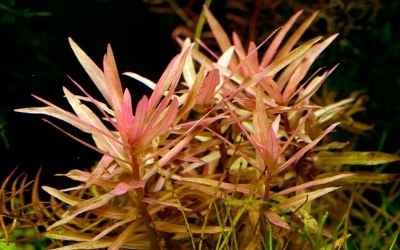Ammannia gracilis is a very attractive and popular aquarium plant among the aquarium enthusiasts due to its brilliant coloration, hardiness and relatively less troublesome growing requirements. It is also known as Red ammannia, Large ammannia, Delicate ammania and Pink ammannia. It was first introduced into the hobby by aquarist P.J. Bussink.
Systematic Position
Distribution and Habitat
It is native to West Africa where it is found in floodplains, marshes, streams and riverbanks. In nature, it prefers to grow with very powerful shoots in sandy soils with minimum nutrients. It is a palustris plant and it can grow in both emerged and submerged conditions. In submerged condition, the leaves are elongated and narrow with red and brown in color while in emerged condition, the leaves become shorter, round and dark olive green in color.
Physical Description
Ammania gracilis has a bare, fleshy and erect stem that extends up to 60 cm in length. The stem bears narrow and wavy leaves which are arranged in opposite direction. The leaves which grow over water surface are linear or back-ovate shape with olive green in color while the underwater leaves have a lanceolate shape.

The color of the leaves vary from a pale green to a bronzy red. These color variation mainly depends on the light intensity and nutrients. The length of water surface leaf is 2-6 cm and width is 1-1.8 cm and the length of underwater leaf is 7-1 cm and width is 0.7-1.8 cm.
Color of the upper part of the leaf can vary from olive green to brownish-red while the lower side has a purple color. The immerse plants produce inconspicuous flowers on the leaf axis. Inflorescence of the plant has 6-7 flowers of pale lilac color. Fruit bears rounded seeds, which has a two-nested spherical shape.
Quick Ammania Gracilis Facts
- check-circle-o
- check-circle-o
Housing and Care Facts
Ammania gracilis is most suited to the mid-ground to background position of aquarium. It can add a brilliant splash of color to any layout. It is a deciduous herbaceous plant with flexuous branches that reach 35-40 cm in height, with flexed, rooted and branched prostrate stem at the base.
To keep Ammania gracilis, at least 100 liters aquarium is required. The tank should have good water quality with a pH of 6.5-7.5, hardness of 6-8 dGH and temperature of 22-28 ° C. The lighting should be moderate to intense with 2-3 watts or more per gallon of tank. For optimum growth of your plants, it needs luminescent lamps with a capacity of 0.4-0.5 Watt per liter volume.
It also needs additional illumination from above. In this case, an incandescent lamp with a power of 25-40 watts is suitable. Lighting should be last for 12 hours in a day. Due to insufficient lighting, the leaves on the lower nodes will begin to turn black. Water changes are recommended from the second week, that is, after 7-10 days of planting and 40-50% water changes should be done weekly basis.
This plant needs proper nutrients. Gravel or sand should be rich in iron and nutrients. CO2 injection should be added at 25-30 ppm. These plants are generally resistant and adaptable in most mild conditions. When it is kept in good condition, this plant grows soon to the surface of the water with sufficient carbon dioxide.
For optimum growth it needs micronutrients as an iron that should be added to the aquarium. If enough iron is present in water the leaves become characteristic color. If there is not enough iron in the water column, the foliage of this plant becomes pale. Low nitrate levels combined with high phosphate content and micronutrient levels will promote the most intense colors in your plants.
Trimming: To keep your plant size attractive, trimming should be done using sharp scissor. In this case, side shoots or lateral branches and top portions should be trimmed.
Propagation / Reproduction
Ammania Gracilis can easily propagate in aquarium condition. It reproduces by seeds or cuttings of stem and side shoots on a substrate. For propagation, you should cut the top of the stem with a pair of scissors and then replant. It can also be propagated by cutting their lateral branches which are then replanted. With proper care, the beautiful plants grow very fast.
For bushier plant, you should cut the stem in the middle position when the top reaches the surface. Each stem should be planted in individual hole. Plants should be planted in the middle of the tank. Before planting, you should provide nutrient rich loose substrate with gentle water circulation. To get quick reddish coloration of your plant, you should supply low amount of nitrates in your tank.
Diseases
Sometimes Ammania gracilis shows abnormal color changes and decay of leaves due to inappropriate lighting and nutrients.
Chlorosis: It is occurred due to lack of proper lighting, CO2 and nutrients such as nitrogen and iron. When the plants suffer from chlorosis, it changes color from purple to yellowish and pale.
Necrosis: Sometimes this plant shows fade or decay in the leaves from its apex and finally, the middle of the whole leaf become a concave curve.
Preventive Measures:
Conclusion
Ammania Gracilis is a very popular aquarium plant. It provides sufficient shelter for your aquarium inhabitants and also adds a brilliant splash of color in your aquarium. It is now available in pet fish store or online shops with sensible cost. We prescribe you to have these gorgeous plants and make your aquarium like in a natural environment. Well, Cabomba caroliniana would also be a good choice.
If you need to know more about aquarium plants please have a look on our review of Best Aquarium Plants For Betta Fish.
